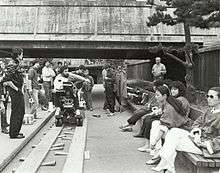Location shooting

Location shooting is the practice of filming in the actual setting in which a story takes place rather than on a sound stage or back lot.[1]
In filmmaking, a location is any place where a film crew will be filming actors and recording their dialog. A location where dialog is not recorded may be considered as a second unit photography site. Filmmakers often choose to shoot on location because they believe that greater realism can be achieved in a "real" place, however location shooting is also often motivated by the film's budget. However, many films shoot interior scenes on a sound stage and exterior scenes on location.
It is often mistakenly believed that filming "on location" takes place in a location where the story is set, but this is not necessarily the case.
Most films do a bit of both location shooting and studio shoots, although low-budget films usually do more location shooting than bigger budget films because the cost of shooting at someplace that already exists is much cheaper than creating that place from scratch. In certain situations it my be cheaper to shoot in a studio. In these situations lower budget films often shoot more in a studio.
Before filming on location its generally wise to conduct a recce.
Pros and cons
Location shooting has several advantages over filming on a studio set:
- It can be cheaper than constructing large sets
- The illusion of reality can be stronger - on a set, it is hard to replicate real-world wear-and-tear, as well as architectural details
- It sometimes allows the use of cheaper non-union labor or to bypass work stoppages in the US. Canadian locations such as Vancouver and Toronto are known for this.
- It sometimes allows "frozen" currency to be used. The 1968 movie Kelly's Heroes was filmed in Yugoslavia using profits that had been made on movie exhibitions in that country but could not be exported.
Its disadvantages include:
- Lack of control over the environment — lighting, passing aircraft, traffic, pedestrians, bad weather, city regulations, etc.
- The difficulty of finding a real-world location which conforms with the requirements of the script
- Members of the audience may be familiar with a real-world location used to double as a fictional location (such as Rumble in the Bronx inexplicably showing the mountains outside Vancouver in the background of an urban Bronx-set scene)
- If a particular location completely lacks production companies (to supply sets and gear) and local film crew, or if what is available locally is not of the desired caliber, then transporting an entire film crew and all their gear just to film on location can be extremely expensive
Location shooting can provide significant economic development benefits to an area selected for shooting. Cast and crew heavily rely upon local facilities such as catering, transportation, and accommodations. A film that becomes a blockbuster hit can introduce movie audiences around the world to a visually breathtaking location that they were previously unaware of. This can boost tourism for years or even decades.
Practicalities
Location shooting usually requires a location manager, and locations are usually chosen by a location scout. Many popular locations, such as New York City in the United States, Toronto in Canada, and the Isle of Man in the United Kingdom, have dedicated film offices to encourage location shooting, and to suggest appropriate locations to film-makers.
In many cases a second unit is dispatched to film on location, with a second unit director and sometimes with stand-in actors. These locations shots can then be edited into the final film or TV program alongside studio-shot sequences, to give an authentic flavour, without the expense or trouble of a full-scale location shoot. NYPD Blue, for example, was filmed primarily in Los Angeles, but used second unit footage of New York City for colour, as well as featuring a small number of episodes filmed on location with the cast.
See also
- Filming location
- Location manager, the person responsible for the locations department
- Location scouting
- Location library
- Filmmaking
References
- ↑ "Shooting on Location Guide to global pre-production location research". Retrieved March 29, 2012.